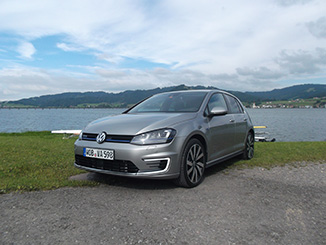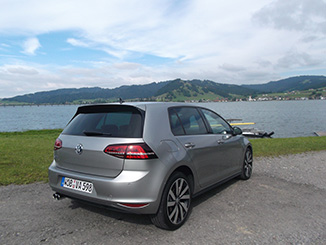Volkswagen Golf GTE and Golf SV


The Golf GTE is the third GT of a model series after the iconic GTI and the excellent GTD, and it has the same sporty DNA. GT stands for Grand Tourer, “I” for injection, “D” for diesel and now “E” for electricity.
The GTE is powered by a 150 ps 1.4 litre TSI petrol engine and a 102ps electric motor, when combined together they produce a maximum power of 204ps.
There are five operating modes: GTE mode, which is maximum power and gives the GTE the sporty nature. battery hold mode, battery charge, hybrid-auto and E-mode, which is where the car runs purely on electric power only, sounds complicated, but it isn’t really once you know where all the buttons are and what they do.
The exterior of the GTE is very GTI with regards to looks; the main difference is that it has blue accents, whereas the GTI has red. Inside too, the red turns to blue, and it looks sporty and has the quality look and feel.
The 8.8kwh lithium-ion battery can be charged in 3.5 hours from a standard domestic mains outlet or 2.5 hours from dedicated home charging wall box.

When we left the airport in the GTE, the battery was fully charged and showed a range of 51km, around 30 miles, and a full tank of petrol. We decided to use the GTE mode, so it used both petrol and electric producing maximum power. The fuel consumption did not seem so bad, but the battery range dropped fairly rapidly. Then we switched to battery hold, were no electricity would be used, and then we tried it through the small Swiss villages on E-mode, which is pure electric.
We drove the GTE around Zurich and up into the hills, though not as far as the mountainous region. It handled so well around the tight twisty roads, and also cruised well on the Swiss motorways. We had to keep a careful eye on the speedometer as the local Police seemed very keen on enforcing the limits. The GTE is quick; it accelerates from 0 to 62mph in 7.6 seconds, and has a definite GTI feel to it.
This Plug-In Hybrid has an official combined fuel consumption figure of 188mpg (NEDC) and 35g/km CO2 emissions (provisional data) and in theory if you charged it every night for 3.5 hours, drove 25 miles the next day, and repeated that for month after month, then you wouldn’t use any petrol and it would be capable of doing 1000’s of miles to one gallon…. but now back to reality…

During the time we used the GTE in Switzerland we used all of the battery power, drove in various drive modes, tried our best to get maximum miles per gallon, but at the end of the route the on-board computer showed we had averaged 5.9 litres per 100km, which is around 47.7mpg, a fair bit off the quoted 188 mpg. But this sort of car has to be driven in certain way, used as much as possible on electricity. The more you run it on petrol, the more expensive it becomes, unless you can plan your journeys around charging points.
The Plug-In Hybrid is certainly the best way to go green at the moment as it has the range of any pure petrol or diesel car, without the range anxiety of full EVs, although you would need to drive it a lot to get your money back. But the more you use it, the more expensive it becomes, so the figures just don’t stack up.
If the driver is going to do an average or above average annual mileage then buying a diesel makes much more sense. But if they intend to stay local, covering a small mileage, then the GTE starts to look the better option, and has the advantage of still being able to go on the long journeys as well.
Prices for the GTE are expected to be around £28,000 (after the Government £5,000 Plug-in Car Grant) and first UK deliveries are expected in March 2015.
The NEDC (New European Driving Cycle for plug-in hybrid cars) needs to be made more realistic, with not just one figure, but three or four to make it clearer for potential buyers, in different driving conditions, using different modes, as these figures are not just slightly out, they are literally miles out….by more than over a 100 miles in this case.
Golf SV – UK Press Launch – Wetherby
In June 2005, Volkswagen launched the Golf Plus, a model based on the Golf Hatchback, but offered added space and flexibility, the all-new successor to the Golf Plus has just been launched, the Golf SV.
The SV measures 4,338mm making it 134mm longer than the Golf Plus that it replaces and 83mm longer than the current Golf hatch
In mainland Europe the SV is known as the Sportsvan, and the UK have very wisely dropped this name, as it is neither Sporty nor a Van.
The exterior design is much prettier and stylish than the Plus, and less utilitarian, much easier on the eye. It does have some nice lines especially the deep swage line that runs down the side of the car from the rear lights to just under the front quarter-light window.
The SV is certainly practical and versatile and has enough room for five adults, with plenty of leg, shoulder and headroom. The rear seats are split 40:60 and slide very easily back and forth, giving either more luggage space, or more leg room for rear seat passengers. The rear seat fold flat by pressing a button, and can be put down or back up again by just using one finger, they are quick and simple to operate.
The SV engine line up is very similar to the Golf hatch and is offered with four trim levels: S, SE, GT and the BlueMotion based on the S trim. The best seller is likely to be the SE 1.6 litre TDI 110ps with a manual taking around 65% of sales.
We drove the SV on a variety of roads around Wetherby, and if you didn’t know it was the SV, you would think you were driving a Golf hatch as it drives and performs in a very similar way. It does not feel “top-heavy” and was a really nice car to be in. The dashboard is all new and quite different to the current Golf it has a more quality feel to it, and I presume this new dash will be fitted in other forthcoming Volkswagens soon.
Prices for the SV are around £900 more than the equivalent Golf hatch derivative. Prices start from £18,875.00 OTR, with the 1.6 TDi SE costing £22,585.00 OTR.
The Golf SV is certainly more desirable and better looking than the car it replaces. It is more competitively priced, so should find homes easier than the Plus.
Martin Ward, Manufacturer Relationship Manager
Golf GTE, Global Press Launch, Zurich


